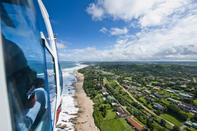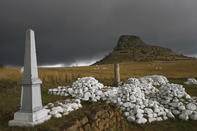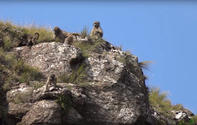You could tour battlefields, beaches and bergs of KwaZulu-Natal in the old family car, or you could do as Justin Fox did and fly-hop them in a helicopter, bubbly corks popping.
The High Life

The chopper was below tree-top height, following the Umhlanga River upstream from the coast. Startled washerwomen in the stream looked up, goats peered down at us from the sides of the gorge. We were flying fast: a roller-coaster ride into rural KwaZulu-Natal.
Our helicopter emerged through a bank of mist and plopped down on a tall, flat-topped koppie. The Valley of a Thousand Hills stretched out in all directions: green, rolling and dotted with Zulu rondavels. It was early morning and the air breathless. Us too. We stepped from the EC120 chopper and host-manager Mark Adcock lit a fire and set to work on breakfast. The sounds of cocks crowing and children playing drifted up from an idyllic pastoral scene below. A sparkling wine cork popped, bacon sizzled over the fire, the journey had begun…
Into the Land of Legends

After an early-morning lift off from Virginia Airfield in Durban North, and our spectacular breakfast, we flew northwest past Tugela Ferry into the heartland of the Zulu battlefields region. The chopper landed at Fugitives’ Drift, which would be our overnight stop. The lodge is known for its famous battlefield tours (even Prince Charles and his boys have visited) guided by David Rattray.
The two most popular tours are to Isandlwana and Rorke’s Drift. The former is the site of a cataclysmic British defeat in 1879, the latter a last-ditched defence that saw 11 Victoria Crosses awarded - the highest number in any single engagement. Late afternoon we arrived at Rorke’s Drift where Rattray talked us through the drama and heroism of the battle.
As the Zulu impis - numbering more than 4 000 men - swept down on a group of just over 100 Welshmen holed up in a makeshift field hospital inside a trading store, it looked as though defeat was inevitable. Rattray recited from letters the soldiers wrote to their mothers just before the fight in which they expected to die. He spoke of the last command issued: “Hold your fire ‘till you can see the whites of their eyes,” and the hours of bloody hand-to-hand combat that ensued.
Rattray is a master storyteller and his is a compassionate tale with a message of empathy and reconciliation. Sitting in the dusk with the shadows stretching across the Rorke’s Drift battleground and listening to Rattray’s emotive telling, there was not a dry eye among us.
From Blood River to Paradise
Next morning we took off just after sunrise, bound for the site of the Battle of Blood River. Rattray was in the co-pilot seat, talking us through the various skirmishes as we flew to that D-shaped-laager monument where Afrikaner and Zulu joined battle.
We landed beside the bronze effigies of Voortrekker wagons; the only people there in the golden morning light. Again Rattray had us enthralled as he recounted the phases of the battle, strategies and the bravery of the fighters on both sides. After dropping Rattray back at his farm we sped south … to the Drakensberg for breakfast. At Cathedral Peak we hung a left, skirting along the basalt battlements. Below were eland and baboons; cruising lammergeiers passed at eye level. It was heart-stopping flying, the EC120 plunging into gorges and soaring along the cliffs.
We touched down at Cleopatra, a ‘gourmet’ lodge high in the foothills just south of Giant’s Castle. It’s a farmhouse with a frontier feel: fireplaces, comfy sofas and a deck cantilevered over a trout dam. Richard and Mouse Poynton are renowned for their innovative food and the breakfast was unforgettable. Mark’s next suggestion was, given our location, surprising: “How about lunch at the beach?” This sounded good to all of us, so the chopper headed for the Wild Coast … then turned south into a 40-knot gale. It wasn’t going to be any old beach, but rather a secluded spot that very few – other than helicopter pilots – could get to.
Picnic Lunch in a Sub-tropical Forest
Somewhere north of Port St Johns we reached Mark’s ‘Paradise’. A waterfall plunged into a lagoon beside a pristine beach hemmed in by green hills. Robin landed the chopper beside the lip of the falls and we hopped out for a picnic lunch in a sub-tropical forest overlooking the beach. I glanced at my watch: it was mid-afternoon and we all had an evening flight out of Durban to catch. The ride back up the coast was thrilling. With the gale from behind, we skimmed along the wave crests like gannets.
Tea was a pit stop on the lawn of the palatial Lynton Hall. Originally home of sugar baron Sir Frank Reynolds, it’s now an elegant, crenulated lodge at the head of Umdoni Park, a picturesque estate with golf course that spreads through coastal forest to the sea. An hour later the EC120 landed beside our SAA jet at Durban International. The dream was over. It was time to say goodbye to the high life and join the queues of economy-class, fixed-wing plebs.
Into Another Dimension
The philosophy behind 5th Dimension Helicopter Safaris is simple. Getting to your destination becomes the highlight of a holiday. You can stop and land anywhere along the way, or even drop in and visit friends. Only Eurocopter EC120s are used: these are quiet in comparison with other choppers and have excellent visibility.
Margy Macduff, who co-runs the company, explained the origin of the name: “Of course you know the three dimensions; but the fourth is time and the fifth dimension is … emotion. Together the five dimensions add up to life!”
On board our helicopter were three journalists, Mark of 5th Dimension and pilot Robin xxx. Ground support was provided by Margy, who followed the helicopter by vehicle with fuel and provisions, leaving us free as birds to go where we wanted. Ours was to be a two-day safari unlike anything we’d ever experienced.
By Justin Fox

